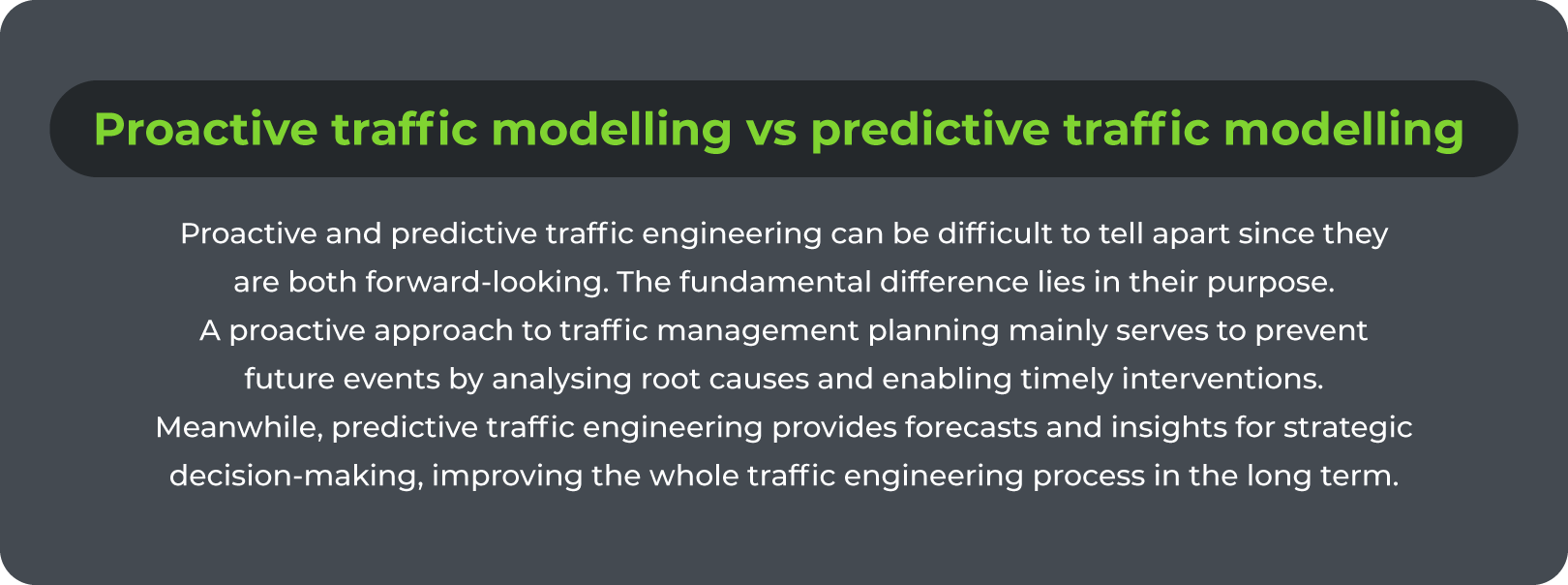Proactive, Predictive, or Reactive? Discussing Different Approaches to Traffic Engineering
What’s the best way to prevent an illness or nip it in the bud once it’s started? A doctor would likely prescribe preventive methods like maintaining a healthy lifestyle, sticking to a nutritious diet, or boosting the immune system once early symptoms appear. But even though it’s old news for most of us, we are still the most likely to act on a sickness only when push comes to shove instead of being proactive by following early signs and predictions.
And while reacting to conditions once they’ve developed is crucial, many could be prevented earlier. Even better, in the near future, healthcare technology will allow us to predict undesirable outcomes well in advance and avoid them altogether.
But why do we talk about it? Because in traffic engineering, too, certain aspects can be avoided or decisions made in advance, at the design stage, to prevent undesirable outcomes and improve the efficiency of proposed solutions. How? By applying appropriate approaches—reactive, proactive, or predictive. Let’s see what each of them offers regarding traffic engineering and urban planning.
What’s reactive traffic engineering?
In traffic engineering, reactive modelling focuses on analysing traffic conditions based on historical data to inform transportation-related decisions. It is a retrospective approach that focuses on understanding past events. In essence, reactive analytics aims to answer questions such as "What happened?" and "Why did it happen?"
For that, the reactive approach uses primarily historical data. These are various traffic metrics collected in the past, usually by public agencies, e.g., transportation departments, metropolitan planning centres, or traffic management organisations. Statistical analysis of this data allows a better understanding of past patterns and variations of traffic flow, speed, volume, occupancy, and density.
Reactive traffic engineering can make informed urban planning and traffic management decisions based on past experiences. With reactive traffic engineering, organisations can develop methods of responding to road incidents and events such as congestion.

Pros and cons of reactive traffic engineering
The reactive approach is a traditional method developed long before the times of AI, big data, or modern traffic video analytics. That’s a blessing and a curse of a reactive approach to traffic management plans.
Most importantly, historical traffic records are readily available. Most cities collect and store some kind of traffic records that can be used to devise efficient intervention methods.
Secondly, efficient, data-informed response measures enabled by reactive traffic engineering are essential in complex cases when predictive traffic models cannot accurately foresee some incidents.
However, reactive traffic engineering isn’t the most agile method. No matter how well-developed response measures are, there’ll always be some lag between the event and the reaction.
Using historical data can also be a detriment. Cities and roads keep evolving, so datasets must be constantly revised for relevance with the current traffic infrastructure to produce dependable results.
What’s proactive traffic engineering?
Rather than responding to an event after it’s occurred, the proactive approach aims to identify its causes and prevent it from happening. For that, proactive traffic planning involves analysing real-time traffic data to take action before an event occurs. The main goal is to identify the root of the problem by finding correlations between dangerous road events and factors like driver behaviour, weather, or road conditions.
A proactive approach to traffic management plans is a forward-looking method that focuses on current data, and as such, it uses more advanced, real-time traffic data collection methods. Its records include among others:
- traffic volume,
- speed,
- and occupancy.
This data is collected from various sources like CCTV cameras, loop detectors, GPS devices, IoT sensors, connected vehicles, or mobile applications.
Modern technologies, mainly machine learning and artificial intelligence, enable continuous real-time traffic monitoring, data processing, and analysis. With their use, automated traffic management systems can be trained to instantly recognise factors that increase the risk of hazardous road events. Then, they can alert traffic managers of the danger or even intervene independently, e.g., by dispatching incident response services.
The proactive approach can be applied to various elements of road infrastructure. For instance, the US Federal Highway Administration deploys ATSPMs (automated traffic signal performance measures) technology to monitor traffic signal performance in real-time rather than relying on observation and reports. With the use of ATSPMs, the agency can identify issues quickly and retime signals based on data.
The pros and cons of proactive engineering
By analysing the factors that lead to road dangers, proactive traffic engineering enables organisations to minimise risks. Based on the real-time traffic data analysis findings, traffic engineers can implement automated intervention measures to react quickly or prevent threats.
One thing a proactive approach to traffic management plans is lacking is the potential for discovery. This approach focuses on identifying the root causes of known traffic issues rather than new strategic improvements of the entire traffic network.
For that, traffic planners will need another model—one that looks into the past, to uncover the possible scenarios in the future.

What is predictive traffic engineering?
This brings us to predictive traffic engineering, which focuses on predicting future outcomes based on historical data. The results can be used to identify new dangers, hypothesise possible scenarios, and inform urban planning.
Since both proactive and predictive models are concerned with the future, it can be difficult to distinguish between them. The key to understanding the difference is their purpose. While proactive traffic planning is focused on root causes, timely interventions, and preventing future events, predictive traffic provides forecasts and insights for strategic decision-making.
Another difference lies in their workings. Like the reactive approach, predictive traffic management plans leverage historical data rather than real-time records to find trends and anticipate future outcomes. To process this information, they involve techniques such as:
- statistical modelling,
- deep learning algorithms,
- data mining,
- and pattern recognition
to build predictive models. The predictive approach provides probabilistic forecasts and predictive scores for specific future events or behaviours. In short, it’s prevention based on the knowledge of current events versus prediction that relies on past datasets.
Predictive technologies have been used in the context of traffic for a long time, most commonly in navigation software. TomTom, for example, combines vast sets of historical data and real-time records with machine learning algorithms to suggest routes that are less likely to get congested in a short time window. The traffic jam feed can generate granular forecasts covering 24-hour flow prediction, jam duration, or tendency.
Although making reliable predictions remains a challenge, particularly in complex traffic networks such as big cities and over longer periods, municipalities and government agencies continue to work on their own solutions. In a recently finished research project, the US Federal Highway Administration tested an AI-based model to predict road conditions and develop new traffic strategies. In Italy, researchers make use of data sourced from car-sharing companies to develop a model capable of discovering interactions between traffic in various city districts and interpreting mobility patterns.
The pros and cons of predictive traffic engineering
Predictive traffic engineering is promising to change traffic management and urban planning in many ways. It may enable accurate volume and flow forecasting, finding previously unknown risks, or optimising public transit routes. Urban planners can use predictive analysis to validate high-cost, high-impact interventions safely.
Still, it’s important to remember that predictive modelling is regarded as the technology of the future not only due to its capabilities but also—its limited availability. While some transportation companies use it in supply chain management and demand forecasts, the technology isn’t readily accessible to everyone due to its complexity, lack of resources, and budget constraints.
However, the prospects of predictive traffic management plans outweigh their cost and requirements, especially as companies like GoodVision work on improving the technology and making it widely available for transport planning purposes.

Just like there’s no golden remedy for every ailment, there’s no single failproof approach to traffic management planning. So, instead of limiting yourself to one technique, try to get the best of all three worlds - this way, you’ll take full advantage of your past and real-time traffic data and get a complete picture of your transportation network. Start today by talking to GoodVision traffic analytics experts!


